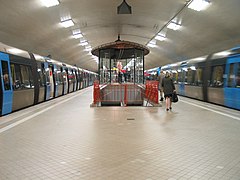Odenplan station
Odenplan island platforms | ||||||||||||||||||||||||||||||||
|---|---|---|---|---|---|---|---|---|---|---|---|---|---|---|---|---|---|---|---|---|---|---|---|---|---|---|---|---|---|---|---|---|
| Tracks | 2 (Metro) 2 (Pendeltåg) | |||||||||||||||||||||||||||||||
| Construction | ||||||||||||||||||||||||||||||||
| Structure type | Underground | |||||||||||||||||||||||||||||||
| Depth | 9 m (30 ft) | |||||||||||||||||||||||||||||||
| Accessible | Yes | |||||||||||||||||||||||||||||||
| Other information | ||||||||||||||||||||||||||||||||
| Station code | Sod, ODP | |||||||||||||||||||||||||||||||
| History | ||||||||||||||||||||||||||||||||
| Opened | 26 October 1952 (Metro) 10 July 2017 (Pendeltåg) | |||||||||||||||||||||||||||||||
| Passengers | ||||||||||||||||||||||||||||||||
| 2019 | 43,750 boarding per weekday (Metro)[1] 42,700 boarding per weekday (Pendeltåg)[1] | |||||||||||||||||||||||||||||||
| Services | ||||||||||||||||||||||||||||||||
| ||||||||||||||||||||||||||||||||
| Other services | ||||||||||||||||||||||||||||||||
| ||||||||||||||||||||||||||||||||
Odenplan station is a station on both the
The station was inaugurated on 26 October 1952 as a part of the stretch of the Metro between Hötorget and Vällingby. It was significantly expanded in July 2017, with the opening of the City Line that provided a dedicated north–south route for the Pendeltåg, serving Odenplan on the way. Besides the new tunnels and platforms for the City Line, new station entrances were constructed, supplementing those built for the Metro.[2][3][4]
The station has two underground island platforms at different levels and on different alignments, with the City Line platforms at the lower level. It has entrances on Odenplan itself, on the north side of Karlbergsvägen opposite Odenplan, at the junction of Karlbergsvägen with Västmannagatan, and at the junction of Vanadisvägen with Dalagaten. The first two entrances provide direct access to both sets of platforms, whilst the Västmannagatan entrance provides direct access to the Metro platforms and Vanadisvägen to the City Line platforms. However both sets of platforms are connected by interchange passages, so it is possible to reach any platform from any entrance. Unlike the Metro platforms, the City Line platforms have platform screen doors.[3][4][5]
The new entrance constructed on Odenplan for the opening of the City Line consists of a rectangular building that is approximately 36 metres (118 ft) long, 8 metres (26 ft) wide and 5 metres (16 ft) high, with one long side facing Karlbergsvägen. The other long side bends gently inwards where stairwells form seats towards the square in the best sun position. The entrance building has five entrances and leads via escalators, ordinary stairs and an elevator down to the new ticket hall. Nearby is a new
Future plans include a diversion of the Roslagsbanan narrow-gauge commuter railway in tunnel from Universitetet station via Odenplan to a terminus at T-Centralen.[6]
The station is 3.4 km from Slussen.[citation needed]
Gallery
-
Barrier lines
-
Metro platforms
-
City Line platforms
-
Location on Metro
-
Location on City Line
References
- ^ a b "Fakta om SL och regionen 2019" (PDF) (in Swedish). Storstockholms Lokaltrafik. pp. 51, 52. Archived (PDF) from the original on 27 December 2020. Retrieved 31 March 2021.
- ^ a b Schwandl, Robert. "Stockholm". urbanrail. Archived from the original on 17 May 2019. Retrieved 7 May 2019.
- ^ a b c "Station Stockholm Odenplan" (in Swedish). Swedish Transport Administration. Archived from the original on 11 March 2017. Retrieved 22 January 2017.
- ^ a b "Citybanans stationer" (in Swedish). Swedish Transport Administration. Archived from the original on 31 January 2017. Retrieved 22 January 2017.
- ^ "Odenplan/Stockholm Odenplan" (PDF). AB Storstockholms Lokaltrafik. Retrieved 25 February 2022.
- ^ "Stockholm to invest SEK30.2 billion in public transport infrastructure by 2035". Global Mass Transit. 31 March 2017. Archived from the original on 21 February 2022. Retrieved 21 February 2021.
External links





